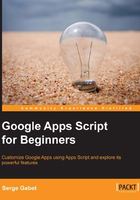
Conventions
In this book, you will find a number of styles of text that distinguish between different kinds of information. Here are some examples of these styles, and an explanation of their meaning.
Code words in text, database table names, folder names, filenames, file extensions, pathnames, dummy URLs, user inputs, and Twitter handles are shown as follows: "As you can notice, we use #name# to mark the placeholders."
A block of code is set as follows:
var docCopy = DriveApp.getFileById(sharedDocID).makeCopy('menu['+headers[todayInSheet]+']');
menuFolder.addFile(docCopy);
DriveApp.getRootFolder().removeFile(docCopy);
When we wish to draw your attention to a particular part of a code block, the relevant lines or items are set in bold:
function myAgeInHours(){
var myBirthDate = new Date('1958/02/19 02:00:00').getTime();
myBirthDate = parseInt(myBirthDate/3600000, 10);
New terms and important words are shown in bold. Words that you see on the screen, in menus or dialog boxes for example, appear in the text like this: "Open the script editor from the Tools menu and write the code snippet we just prepared.".